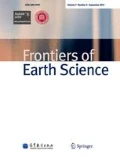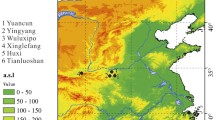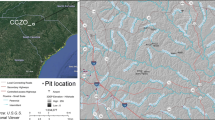Abstract
The accurate radiocarbon dating of loess-soil sequences plays an essential role in the reconstruction of the environmental and climatic changes in continental settings during the last glaciation and Holocene. However, our knowledge about the reliability of radiocarbon ages of various fractions of soil and loess samples is still insufficient. Here, we present our study results on radiocarbon ages based on bulk organic matter, humin fraction, and carbonate of samples collected from a loess-paleosol section in the western Chinese Loess Plateau. We compare these observations with the optically stimulated luminescence ages and charcoal radiocarbon ages to evaluate the reliability of these fractions. We observed that the radiocarbon ages of humin fraction are very close to those of charcoal and are consistent with the optically stimulated luminescence ages within the experimental errors. We observed a significant deviation in the radiocarbon ages of carbonate and bulk organic matter from those of charcoal and optically stimulated luminescence ages, likely due to the dilution of these fractions during the pedogenetic process. Our results reveal that, except for charcoal, the humin fraction may yield reliable 14C ages for the Chinese loess-soil sequence.
Similar content being viewed by others
References
Barton L, Newsome S D, Chen F H, Wang H, Guilderson T P, Bettinger R L (2009). Agricultural origins and the isotopic identity of domestication in northern China. Proc Natl Acad Sci USA, 106(14): 5523–5528
Bettinger R L, Barton L, Morgan C, Chen F H, Wang H, Guilderson T P, Ji D X, Zhang D J (2010). The transition to agriculture at Dadiwan, People’s Republic of China. Curr Anthropol, 51(5): 703–714
Björck S, Bennike O, Possnert G, Wohlfarth B, Digerfeldt G (1998). A high-resolution 14C dated sediment sequence from southwest Sweden: age comparisons between different components of the sediment. J Quaternary Sci, 13(1): 85–89
Chen F H, Bloemendal J, Feng Z D, Wang J M, Parker E, Guo Z T (1999). East Asian monsoon variations during Oxygen Isotope Stage 5: evidence from the northwestern margin of the Chinese Loess Plateau. Quat Sci Rev, 18(8–9): 1127–1135
Chen F H, Bloemendal J, Wang J M, Li J J, Oldfield F (1997). Highresolution multiproxy climate records from Chinese loess: evidence for rapid climatic changes over the last 75 kyr. Palaeogeogr. Palaeoclimatol. Palaeoecol, 130(1–4): 323–335
Cook G T, Dugmorez A J, Shore J S (1998). The influence of pretreatment on humic acid yield and 14C age of Carex peat. Radiocarbon, 40(1): 21–27
Ding Z L, Xiong S F, Sun J M, Yang S L, Gu Z Y, Liu T S (1999). Pedostratigraphy and paleomagnetism of a 7.0 Ma eolian loess-red clay sequence at Lingtai, Loess Plateau, north-central China and the implications for paleomonsoon evolution. Palaeogeogr. Palaeoclimatol. Palaeoecol, 152(1–2): 49–66
Dodson J R, Zhou W J (2000). Radiocarbon dates from a Holocene deposit in southwestern Australia. Radiocarbon, 42(2): 229–234
Fontana S L (2007). Radiocarbon chronologies of Holocene lacustrine sediments from the southern coast of Buenos Aires province, Argentina. Radiocarbon, 49(1): 103–116
Forbs M, Bestland E, Wells R (2004). Preliminary 14C dates on bulk soil organic matter from the black creek Megafauna fossil site, Rocky River, Kangaroo Island, South Australia. Radiocarbon, 46(1): 437–443
Geyh M A, Roeschmann G, Wijmstra TA, Middeldorp A A (1983). The unreliability of 14C dates obtained from buried sandy Podzols. Radiocarbon, 25(2): 409–416
Goh K M, Molloy B P J (1978). Radiocarbon dating of paleosoils using soil organic matter components. J Soil Sci, 29(4): 567–573
Guo Z T, Ruddiman WF, Hao Q Z, Wu H B, Qiao Y S, Zhu R X, Peng S Z, Wei J J, Yuan B Y, Liu T S (2002). Onset of Asian desertification by 22 Myr ago inferred from loess deposits in China. Nature, 416(6877): 159–163
Hatte C, Pessenda L C, Lang A, Paterne M (2001). Development of accurate and reliable 14C chronologies for loess deposits: application to the loess sequence of nussloch (Rhine valley, Germany). Radiocarbon, 43(2B): 611–618
Liu T S (1985). Loess and the Environment. Beijing: China Ocean Press (in Chinese)
Lu H Y, An Z H (1998). Pretreated methods on loess-palaeosol samples granulometry. Chin Sci Bull, 43(3): 237–240
Mayer J H, Burr G S, Holliday V T (2008). Comparisons and interpretations of charcoal and organic matter radiocarbon ages from buried soils in North-Central Colorado, USA. Radiocarbon, 50: 331–346
McGeehin J, Burr G S, Jull A J T, Reines D, Gosse J, Davis P T, Muhs D, Southon J R (2001). Stepped-combustion 14C dating of sediment: a comparison with established techniques. Radiocarbon, 43(2A): 255–261
Muhs D R, Ager T A, Bettis E A, McGeehin J, Been J M, Begét J E, Pavich M J, Stafford T W Jr, Stevens D A S P (2003). Stratigraphy and palaeoclimatic significance of Late Quaternary loess-palaeosol sequences of the Last Interglacial-Glacial cycle in central Alaska. Quat Sci Rev, 22(18–19): 1947–1986
Olsson I U (2009). Radiocarbon dating history: early days, questions, and problems met. Radiocarbon, 51(1): 1–43
Orlova L A, Panychev VA (1993). The reliability of radiocarbon dating buried soil. Radiocarbon, 35(3): 369–377
Pachur H J, Wünnemann B, Zhang H C (1995). Lake evolution in the Tengger Desert, northwestern China during the last 40000 years. Quat Res, 44(2): 171–180
Pessenda L C R, Aravena R, Melfi A J, Telles E C C, Boulet R, Valencia E P E, Tomazello M (1996). The use of carbon isotopes (13C, 14C) in soil to evaluate vegetation changes during the Holocene in Central Brazil. Radiocarbon, 38(2): 191–201
Pessenda L C R, Gouveia S E M, Aravena R (2001). Radiocarbon dating of total soil organic matter and humin fraction and it’s comparison with 14C age of fossil charcoal. Radiocarbon, 43(2b): 596–601
Pigati J S, Quade J, Wilson J, Jull A J T, Lifton N A (2007). Developments of low-background vacuum extraction and graphitization system for 14C dating of old (40–60 ka) samples. Quat Int, 166(1): 4–14
Reimer P J, Baillie M G L, Bard E, Bayliss A, Beck JW, Blackwell P G, Ramsey C B, Buck C E, Burr G S, Edwards R, Friedrich M, Grootes P M, Guilderson T P, Hajdas I, Heaton T J, Hogg A G, Hughen K A, Kaiser K F, Kromer B, McCormac F G, Manning S W, Reimer RW, Richards D A (2009). Intcal09 and Marine09 radiocarbon age calibration curves 0–50,000 years cal BP. Radiocarbon, 51(4): 1111–1150
Stuiver M, Reimer P J (1993). Extended 14C data base and revised CALIB 3.0 14C age calibration program. Radiocarbon, 35(1): 215–230
Törnqvist T E, de Jong A F M, Oosterbaan WA, van der Borg K (1992). Accurate dating of organic deposits by AMS 14C measurement of macrofossils. Radiocarbon, 34(3): 566–577
Turney C S M, Coope G R, Harkness D D, Lowe J J, Walker M J C (2000). Implications for the dating ofWisconsinan (Weichselian) late glacial events of systematic radiocarbon age differences between terrestrial plant macrofossils from a site in SW Ireland. Quat Res, 53(1): 114–121
Wang Y, Amundson R, Trumbore S (1996). Radiocarbon dating of soil organic matter. Quat Res, 45(3): 282–288
Yang B, Shi Y F, Braeuning A, Wang J X (2004). Evidence for a warmhumid climate in arid northwestern China during 40 - 30 ka BP. Quat Sci Rev, 23(23-24): 2537–2548
Yu F H (2007). Situation and Comparison of Carbonate Detection Methods. Marine Geology Letters, 23(1): 35–39 (in Chinese)
Zhang D J, Chen F H, Bettinger R L, Barton L, Ji D X, Morgan C, Wang H, Cheng X Z, Dong G H, Guilderson T P, Zhao H (2010). Archaeological records of Dadiwan in the past 60 ka and the origin of millet agriculture. Chin Sci Bull, 55(16): 1636–1642
Zhao H, Chen F H, Li S H, Wintle A G, Fan Y X, Xia D S (2007). A record of Holocene climate change in the Guanzhong Basin, China. The Holocene, 17(7): 1015–1022
Author information
Authors and Affiliations
Corresponding author
Rights and permissions
About this article
Cite this article
Wang, Z., Zhao, H., Dong, G. et al. Reliability of radiocarbon dating on various fractions of loess-soil sequence for Dadiwan section in the western Chinese Loess Plateau. Front. Earth Sci. 8, 540–546 (2014). https://doi.org/10.1007/s11707-014-0431-1
Received:
Accepted:
Published:
Issue Date:
DOI: https://doi.org/10.1007/s11707-014-0431-1




